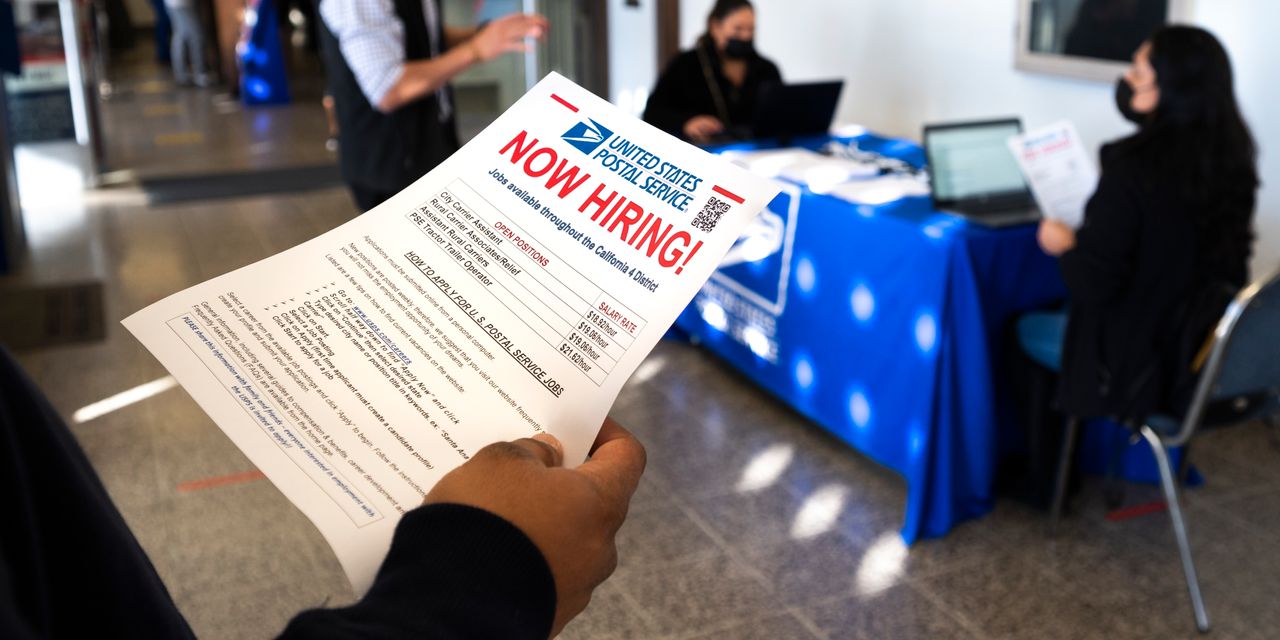
Since bottoming out in early 2020, the U.S. economy has handily outperformed other major advanced countries, except in one crucial dimension: its labor force.
Between the fourth quarters of 2019 and 2021, the labor-force participation rate—the share of the population ages 15 to 64 either working or looking for work—dropped 0.7 percentage point in the U.S., while rising in Japan and Canada, according to the Organization for Economic Cooperation and Development, an association of advanced economies. The eurozone’s participation rate was also well above its pre-pandemic level in the third quarter, the latest for which data is available.
While much of the decline in the U.S. labor force is because of retirement, its participation rate for people ages 25 to 54 has also fallen more than in other countries.
The Labor Department reported Friday that the U.S. participation rate was 62.2% in January compared with 61.9% in December. However, the increase was due to new population estimates introduced in January. If they had been applied to December, participation wouldn’t have changed.
The sources of this discrepancy could help answer another question: Why is U.S. inflation higher than in other countries? It appears to be a combination of stronger demand and more constricted supply, including of labor.
One cause of the divergence is differing approaches to supporting workers in the early months of the pandemic. European governments historically sought to keep workers in their jobs during downturns, and Japanese companies have long given priority to preserving head count. The U.S. has instead supported laid off workers directly, facilitating the transition to new jobs and new industries.
During the pandemic, European and Japanese employers furloughed rather than fired employees, with governments subsidizing the furloughed workers’ salaries. The U.S. had its own version, the Paycheck Protection Program, which gave forgivable loans to businesses that held on to their employees, but the impact was relatively small. Most federal support came through enhanced unemployment insurance for millions of laid-off workers.
SHARE YOUR THOUGHTS
What do you think is behind the decline in the U.S. labor force? Join the conversation below.
As a result, bonds between employers and employees were more likely to be severed in the U.S. than in Europe. Such bonds take a long time to restore, notes Izumi Devalier, head of Japan economics for Bank of America. “Usually this is not a big deal because demand recovers only gradually…but Covid just ended up being a different kind of shock, as demand snapped back super quickly,” she said. So when U.S. employers went to staff up again, many former workers had already moved on or quit the labor market.
Differing wage subsidies, however, can’t explain why participation is lower in the U.S. than in Canada, where the subsidy plan was similar to that of the U.S. and not particularly effective, according to Miles Corak, a Canadian economist teaching at the City University of New York.
Here, Covid-19 may have played a role. Cumulative infections and deaths from the virus are about three times higher, per capita, in the U.S. than in Canada—almost certainly affecting the willingness and ability to work. U.S. monthly labor-force surveys show the number of people absent from their jobs because of illness averaged 50% higher last year than in 2019. Over the same period Canada’s corresponding survey showed 16% more workers missing a full week of work because of illness or disability, and 13% fewer missing part of a week.
Japan’s pandemic experience has been even less severe, with 10% of the infections and 5% of the deaths, per capita, as the U.S. The number of Japanese workers out of the labor force for health reasons was actually lower last year than in 2019, Ms. Devalier found.
Linking labor market outcomes with a country’s Covid-19 experience is tricky when so many other factors are also at work and data isn’t strictly comparable. Income and wealth gains in the U.S. may have made retiring early or taking time off easier for Americans worried about Covid-19 or unhappy with their jobs.
Nonetheless, reduced labor participation helps explain why the U.S. is an outlier in so many ways. Strong demand has propelled rapid growth since mid-2020, but employers trying to meet that demand have run into persistent labor shortages. The ratio of job vacancies to unemployed is near a record high. Employers are thus asking current employees to work harder: Employment has lagged more in the U.S. than in other countries, yet total hours worked haven’t.
Employers are also paying more to attract and retain workers, with labor costs rising much more in the U.S. than in other countries, the International Monetary Fund has found. That is one, although not the main, reason U.S. inflation is also higher.
This evidence hints that if Covid-19 becomes more predictable and less lethal after the Omicron wave passes, as many health experts hope, then the obstacle it poses to work should also ease.
Stefano Scarpetta, director of employment, labor and social affairs at the OECD, noted that European labor markets are often bifurcated between secure, well-paying jobs and insecure, poorly paid contract jobs. If you have a secure job, “you think twice before you quit the labor market because it’s much harder coming back.” That bifurcation doesn’t exist in the U.S., so workers are more likely to drop out of the labor force knowing they can easily return.
But there is no guarantee that Covid-19 will recede or that when workers who left the labor force decide to return, jobs will be as plentiful as they are now.
Corrections & Amplifications
Izumi Devalier is the head of Japan economics for Bank of America. An earlier version of this article incorrectly referred to Ms. Devalier as Ms. Izumi. (Feb. 4)
Write to Greg Ip at [email protected]
Copyright ©2022 Dow Jones & Company, Inc. All Rights Reserved. 87990cbe856818d5eddac44c7b1cdeb8








